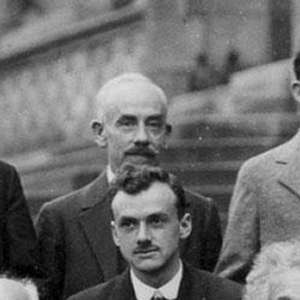Théophile de Donder
| Théophile de Donder | |
|---|---|
|
Théophile Ernest de Donder (1872 – 1957) at the 1927 Solvay Conference. Appearing in front of de Donder is Paul Dirac. | |
| Born |
19 August 1872 Brussels, Belgium |
| Died |
11 May 1957 (aged 84) Brussels, Belgium |
| Residence | Belgium |
| Nationality | Belgian |
| Fields | Physicist and mathematician |
| Institutions | Université Libre de Bruxelles |
| Alma mater | Université Libre de Bruxelles |
| Academic advisors | Henri Poincaré |
| Doctoral students |
Ilya Prigogine Jules Géhéniau Léon Van Hove Raymond Coutrez Théophile Lepage |
| Known for | Being the father of irreversible thermodynamics |
| Influences | Albert Einstein |
Théophile Ernest de Donder (French: [də dɔ̃dɛʁ]; 19 August 1872 – 11 May 1957) was a Belgian mathematician and physicist famous for his work (published in 1923) in developing correlations between the Newtonian concept of chemical affinity and the Gibbsian concept of free energy.
Education
He received his doctorate in physics and mathematics from the Université Libre de Bruxelles in 1899, for a thesis entitled Sur la Théorie des Invariants Intégraux (On the Theory of Integral Invariants).[1]
Career
He was professor between 1911 and 1942, at the Université Libre de Bruxelles. Initially he continued the work of Henri Poincaré and Élie Cartan. From 1914 on, he was influenced by the work of Albert Einstein and was an enthusiastic proponent of the theory of relativity. He gained significant reputation in 1923, when he developed his definition of chemical affinity. He pointed out a connection between the chemical affinity and the Gibbs free energy.
He is considered the father of thermodynamics of irreversible processes.[2] De Donder’s work was later developed further by Ilya Prigogine. De Donder was an associate and friend of Albert Einstein.
Books by De Donder
- Thermodynamic Theory of Affinity: A Book of Principles. Oxford, England: Oxford University Press (1936)
- The Mathematical Theory of Relativity. Cambridge, MA: MIT (1927)[3]
- Sur la théorie des invariants intégraux (thesis) (1899).
- Théorie du champ électromagnétique de Maxwell-Lorentz et du champ gravifique d'Einstein (1917)
- La gravifique Einsteinienne (1921)
- Introduction à la gravifique einsteinienne (1925)[4]
- Théorie mathématique de l'électricité (1925)[5]
- Théorie des champs gravifiques (1926)[6]
- Application de la gravifique einsteinienne (1930)
- Théorie invariantive du calcul des variations (1931)[7]
See also
References
- ↑ Acad. Roy. Belg., Bull. Cl. Sc., page 169, 1968.
- ↑ Perrot, Pierre (1998). A to Z of Thermodynamics. Oxford University Press. ISBN 0-19-856556-9.
- ↑ Struik, D. J. (1930). "Review: The Mathematical Theory of Relativity, by Th. de Donder" (PDF). Bull. Amer. Math. Soc. 36 (1): 34. doi:10.1090/s0002-9904-1930-04878-8.
- ↑ Reynolds Jr., C. N. (1926). "Review: Introduction à la Gravifique einsteinienne, by Th. de Donder" (PDF). Bull. Amer. Math. Soc. 32 (5): 563. doi:10.1090/s0002-9904-1926-04273-7.
- ↑ Page, Leigh (1926). "Review: Théorie Mathématique de l'Électricité, by Th. de Donder" (PDF). Bull. Amer. Math. Soc. 32 (2): 174. doi:10.1090/s0002-9904-1926-04191-4.
- ↑ Reynolds Jr., C. N. (1929). "Review: Théorie des Champs Gravifiques, by Th. de Donder" (PDF). Bull. Amer. Math. Soc. 35 (6): 884. doi:10.1090/s0002-9904-1929-04828-6.
- ↑ Busemann, Herbert (1937). "Review: Théorie Invariantive du Calcul des Variations, by Th. de Donder" (PDF). Bull. Amer. Math. Soc. 43 (9): 598–599. doi:10.1090/s0002-9904-1937-06582-7.
External links
| Wikiquote has quotations related to: Théophile de Donder |
- Theophile de Donder - Science World at Wolfram.com
- Prigogine on de Donder
- De Donder's math genealogy
- De Donder's academic tree
